Pink Park Village is one of the first hospice centers in Thailand, created with a natural healing concept to be a care center for end-stage breast cancer patients in need.
Text: Kitti Chaowana
Photo: Ketsiree Wongwan
Download the online journal Issue 01 The ComfortZone Click here
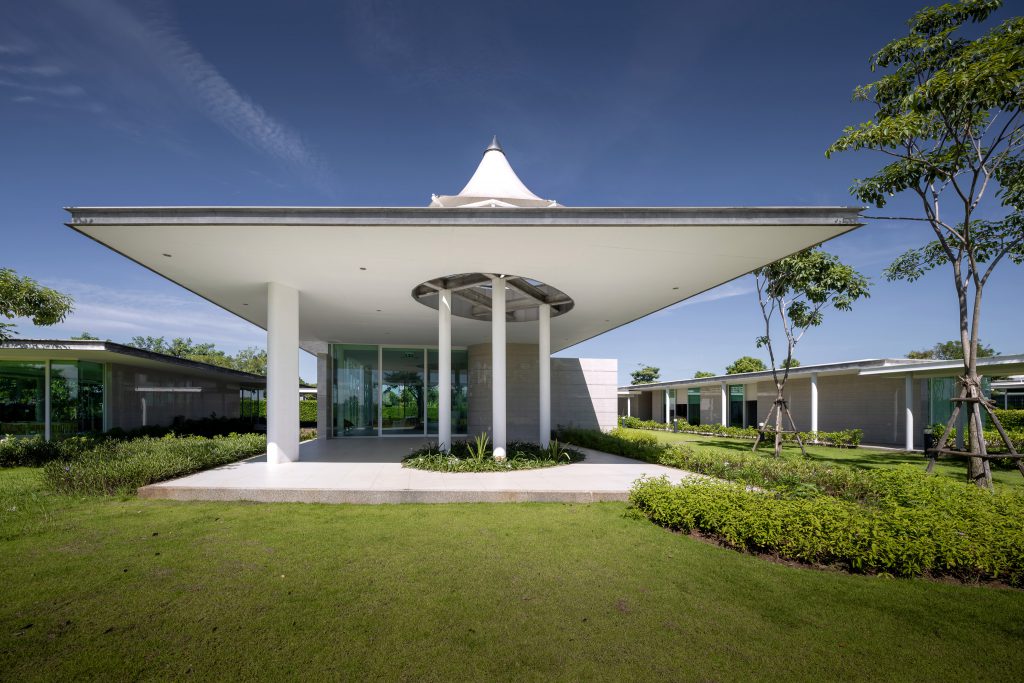
ทั้งสวนและท้องฟ้าให้มากที่สุดเพื่อความสบายตา
Photo: Ketsiree Wongwan
แม้เราจะยอมรับว่าการเกิด-แก่-เจ็บ-ตาย เป็นเรื่องปกติในแต่ละช่วงชีวิตแต่ “ความตาย” ก็ยังดูน่ากลัวเสมอสำหรับทุกคน โดยเฉพาะเมื่อเรารู้ตัวว่าเราจะต้องตายในเวลาอันใกล้จากการเจ็บป่วยที่ยากจะเยียวยา เราจะสามารถเตรียมพร้อมรับการเปลี่ยนแปลง ครั้งสุดท้ายของชีวิตสามารถพาตัวเองและครอบครัวญาติมิตรผ่านการสูญเสียได้อย่างไร สถานที่แบบไหนกันที่จะช่วยให้เราผ่านพ้นความเจ็บปวดทรมานจากโรคร้ายให้พร้อมรับความตายได้อย่างสงบ ยังมีข้อถกเถียงเชิงจริยธรรมอย่างกว้างขวางถึงการเลือกตายอย่างสงบโดยมีมนุษยธรรมในปัจจุบันมีเพียงไม่กี่ประเทศเท่านั้นที่มีกฎหมายรองรับการุณยฆาต (Euthanasia) ซึ่งมีแพทย์เป็นผู้ดำเนินการในประเทศไทยยังไม่มีกฎหมายรองรับเรื่องดังกล่าวจึงสามารถทำได้เพียงการดูแลผู้ป่วยระยะสุดท้ายด้วยการดูแลแบบประคับประคอง (Palliative Care) เท่านั้นและเมื่อได้รับการวินิจฉัยว่าเป็นผู้ป่วยระยะ ท้ายไม่สามารถรักษาหาย หรือระยะสุดท้ายที่มีอาการทรุดหนักและได้รับการวินิจฉัยว่าจะเสียชีวิตในไม่ช้า จะเกิดผลกระทบตามมาอีกมากมาย เช่น ความเครียดสะสมของผู้ป่วยและญาติ ความต้องการเตียงในการรักษา ผู้ป่วยของโรงพยาบาล ค่าใช้จ่ายในโรงพยาบาลที่สูงหรือความต้องการของผู้ป่วยส่วนใหญ่ที่ต้องการจะเสียชีวิตที่บ้าน โดยมีโอกาสได้ใช้ชีวิตบั้นปลายกับครอบครัวหรือสามารถเลือกวาระสุดท้ายของตนเองได้ในขณะที่ครอบครัวเองก็อาจขาดความพร้อมในการการดูแลผู้ป่วยระยะท้าย
การบริบาลผู้ป่วยระยะท้ายในปัจจุบันมุ่งเน้นให้ผู้ป่วยและครอบครัวที่ใกล้ชิดมีคุณภาพชีวิตที่ดี เป็นการดูแลแบบประคับประคอง (Palliative Care) โดยทีมสหสาขาวิชาชีพในสถาน ที่และสิ่งแวดล้อมที่มีการจัดไว้อย่างเหมาะสม ด้วยจุดมุ่งหมายเพื่อบรรเทาทุกข์ทรมานและเสริมสร้างคุณภาพชีวิตทางสุขภาพของผู้ป่วย และครอบครัวครอบคลุมช่วงระยะท้ายของชีวิต (Terminal Phase) รวมถึงในช่วงระยะเวลาแรกหลังการเสียชีวิตของผู้ป่วย (Bereave- ment Phase) “บ้านพิงพัก” (Pink Park Village) เป็นหนึ่งในสถานบริบาลผู้ป่วยระยะท้าย (Hospice Centre) แห่งแรกๆ ของประเทศไทยที่สร้างขึ้นเพื่อเป็นศูนย์ดูแลผู้ป่วยมะเร็งเต้านมระยะสุดท้ายแก่ผู้ยากไร้ โดยไม่แสวงหาผลกำไรภายใต้การบริหารของมูลนิธิศูนย์มะเร็งเต้านมเฉลิมพระเกียรติ (Queen Sirikit Centre for Breast Cancer Foundation) บนที่ดิน 121 ไร่ แถบหนองจอก ซึ่งคุณบุญสมสุขจารุวัฒนะ ได้บริจาคที่นาให้แก่มูลนิธิฯ ในการดำเนินโครงการร่วมกับการระดมทุนจากภาคส่วนต่างๆ ทั้งภาคธุรกิจและภาคประชาสังคมอย่างต่อเนื่องและกว้างขวาง ทั้งงบประมาณในการก่อสร้าง การบริจาค วัสดุในการก่อสร้าง และงบประมาณในการดำเนินโครงการโดยมีองค์ประกอบหลักของโครงการ คือ บ้านพักและสถานที่ดูแลผู้ป่วยระยะสุดท้าย (Hospice Centre) บ้านพักฟื้นสำหรับผู้ป่วยที่กำลังทำการรักษา (Convalescence Centre) ศูนย์กิจกรรมระหว่างวัน (Day Care & Activity Centre) ศูนย์การเรียนรู้และฝึกอบรม (Learning & Training Centre) ศูนย์วิจัยและวินิจฉัยโรคมะเร็งเต้านม (Diagnostic Centre) กลุ่มอาคารสวดมนต์ทำสมาธิและศาสนกิจแต่ละศาสนา (A Multifaith Spiritual Support Centre) และฟาร์มเกษตรอินทรีย์ชุมชน (Organic Community Orchards and Farm) ซึ่ง รศ.นพ.กฤษณ์ จาฏามระ ประธานกรรมการมูลนิธิฯกล่าวถึงความตั้งใจให้โครงการบ้านพิงพักเป็น “การยกระดับมาตรฐานการรักษาและดูแลผู้ป่วยโรคมะเร็งเต้านมของประเทศไทยให้เทียบเท่าระดับสากล เพื่อให้มูลนิธิฯ เป็นที่พึ่งของผู้หญิงไทยอย่างแท้จริง”
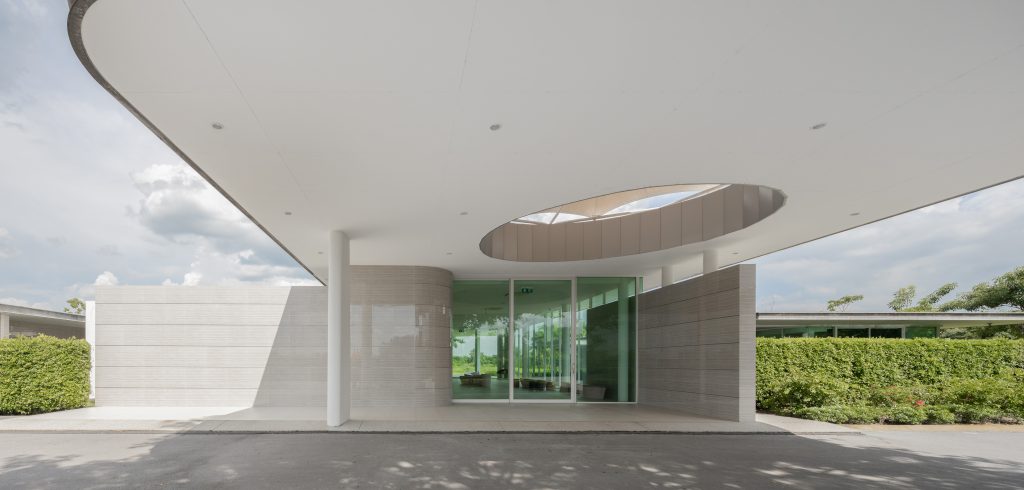
Photo: Ketsiree Wongwan
เนื่องจากระหว่างการบำบัดรักษาผู้ป่วยมะเร็งระยะสุดท้ายทั้งผู้ป่วยและคนใกล้ชิดจะมีความเปราะบางทั้งทางร่างกาย อารมณ์ และ จิตวิญญาณ การสร้างภูมิทัศน์ที่ดีจึงเป็นส่วนสำคัญที่ช่วยสร้างความสุข สงบ ผ่อนคลาย แก่ผู้ป่วยที่บำบัดรักษาแบบประคับประคองในวาระสุดท้ายของชีวิตตามหลัก “ธรรมชาติบำบัด (Natural Therapy)” ผู้ออกแบบวางผังและภูมิสถาปัตยกรรม บริษัท P Landscape นำเสนอแนวคิดของ “Landscape Architecture is the creation of life” โดยวางอาคารขนาดเล็กตามความจำเป็นกระจายตัวกลมกลืนไปกับภูมิทัศน์ พื้นที่โครงการกว่าครึ่ง จึงถูกจัดเป็นพื้นที่สวนอีกทั้งมีการจัดเตรียม
พื้นที่สวนเกษตรอินทรีย์ในส่วนต่อขยายใน อนาคตเป็นพื้นที่สานสัมพันธ์ร่วมกับชุมชน ท้องถิ่นโดยรอบ มีการใช้แนวคิดเกษตรวิถี ธรรมชาติ (Permaculture) เพื่อแสดงให้เห็น ถึงการเติบโตและการเปลี่ยนแปลงของชีวิต ซึ่งเป็นส่วนหนึ่งของการมีชีวิตตามธรรมชาติ การออกแบบเน้นแนวแกนส่วนกลางของโครงการด้วยการจัดภูมิทัศน์ที่โดดเด่นจากต้นชมพูพันธุ์ทิพย์ซึ่งมีดอกสีชมพูสวยงามเป็นองค์ประกอบหลัก ซึ่งเป็นสัญลักษณ์ที่สื่อถึงมะเร็งเต้านมร่วมกับการจัดภูมิทัศน์สนามหญ้าและไม้ดอกคลุมดินสีชมพูซึ่งตลอดทางเดินลัดเลาะเชื่อมระหว่างอาคารต่างๆ เพื่อให้ผู้ป่วยรู้สึกผ่อนคลายอบอุ่นใจเหมือนบ้านอีกหลังหนึ่ง จากเดิมที่เป็นทุ่งนามีการออกแบบ บ่อน้ำเพื่อเป็นองค์ประกอบหลักในภูมิทัศน์ที่สวยงามเพื่อให้รู้สึกสงบ ผ่อนคลาย โดยการนำดินที่ขุดไปถมเป็นเนินดินโดยรอบโครงการและแก้ปัญหาน้ำท่วมและได้พื้นที่รับน้ำาเพื่อใช้ประโยชน์ในโครงการในอีกทางหนึ่ง
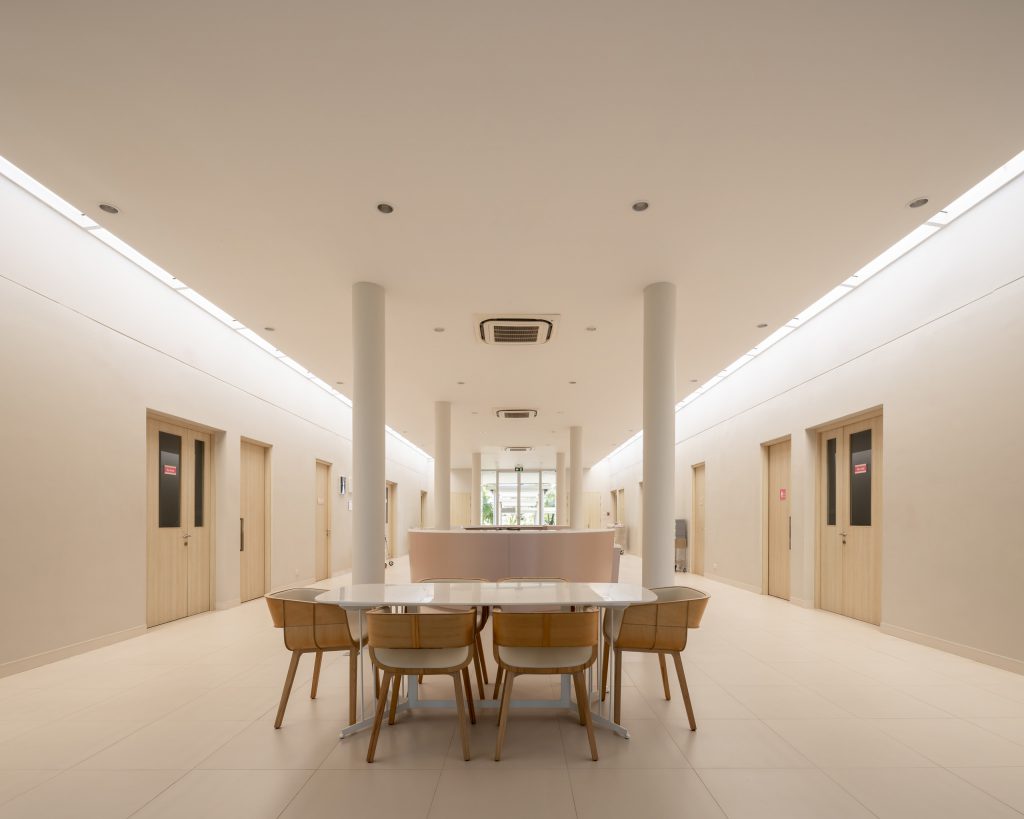
Photo: Ketsiree Wongwan
นอกจากจะใช้แนวคิดธรรมชาติบำบัดเป็นแนวคิดหลักของโครงการแล้วในกระบวนการออกแบบสถาปัตยกรรมได้มีการระดมความคิดจากผู้มีส่วนเกี่ยวข้องในการใช้โครงการทั้งผู้ป่วย บุคลากรทางการแพทย์ และผู้ดูแลผู้ป่วยในสหสาขาวิชาเพื่อพัฒนาโจทย์และทางเลือกในการสร้างสรรค์พื้นที่ส่วนต่างๆ เพื่อให้ผู้ป่วยมีคุณภาพชีวิตที่ดีที่สุดในวาระสุดท้ายอาคารทั้งหมดจะออกแบบตกแต่งให้รู้สึกสบายตาเชื่อมโยงพื้นที่ในอาคารให้ต่อเนื่องกับต้นไม้และท้องฟ้ามากที่สุด มีการเตรียมพื้นที่เพื่อติดตั้งงานศิลปะเพื่อช่วยให้ผู้ป่วยรู้สึกผ่อนคลายสบายใจในพื้นที่โถงหลักของโครงการ โดยผู้ร่วมออกแบบด้านสถาปัตยกรรม บริษัท ไอวิวดีไซน์ สตูดิโอ และ ดีบีสตูดิโอ ออกแบบให้ส่วนห้องพักผู้ป่วยกระจายตัวโดยมี Nurse Station และพื้นที่สันทนาการรวมอยู่ส่วนกลางของแต่ละกลุ่มอาคารที่เปิดมุมมองต่อเนื่องกับสวนโดยรอบในขณะที่มีการยกระดับ พื้นอาคารทั้งหมดสูงกว่าทางเดินโดยรอบประมาณ 1.20 ม. เพื่อผู้ป่วยในโครงการจะมองไม่เห็นการเข็นเตียงผู้ป่วยที่เสียชีวิตออกนอกพื้นที่โดยเร็วผ่านทางลาดต่างระดับซึ่งได้จัดเตรียมไว้โดยรอบ ผู้ออกแบบได้นำเสนอพื้นที่อาคารศาสนกิจแต่ละศาสนารอบสระน้ำให้ผู้ป่วยได้สวดมนต์ ทำสมาธิ และศาสนกิจ เพื่อยกระดับจิตใจให้สงบ พร้อมยอมรับการ เปลี่ยนแปลงครั้งสำคัญครั้งสุดท้ายตามหลักคำสอนของแต่ละศาสนา โดยออกแบบให้มีการลดทอน เรียบง่าย ต่อเนื่องกับพื้นน้ำและธรรมชาติโดยรอบ
บ้านพิงพักเป็นหนึ่งในตัวอย่างที่ดีที่แสดงให้เห็นว่าความตั้งใจของผู้คนในทุกภาคส่วนในสังคม รวมทั้งผู้ออกแบบที่พร้อมจะศึกษา เรียนรู้ ทำความเข้าใจผู้ใช้โครงการอย่างลึกซึ้ง สามารถสนับสนุนให้เกิดสถาปัตยกรรมใหม่ๆ ที่เติมเต็มความสุขให้กับผู้คนได้เป็นอย่างดีเป็นอีกพื้นที่ที่ได้ทำหน้าที่จุดประกายความ คิดส่งต่อแรงบันดาลใจในการสร้างพื้นที่ สร้างสรรค์ ตอบสนองประเด็นใหม่ๆ ในบริบท สังคมที่มีความหลากหลายได้อย่างน่าสนใจ โดยเฉพาะการตระหนักถึงคุณค่าของการมี ชีวิตที่ดีจนถึงวาระสุดท้ายที่หลีกเลี่ยงไม่ได้ ด้วยความเข้าใจในเมื่อสถาปัตยกรรมเป็น ภาพสะท้อนสังคมแต่ในหลายสถานการณ์พบว่าสภาพแวดล้อมเดิมที่มีไม่ได้ตอบสนอง คุณภาพการใช้งานที่ดีทั้งด้านกายภาพและด้านจิตใจจะดีแค่ไหนหากสถาปนิกผู้ออกแบบ สภาพแวดล้อมได้เรียนรู้ปัญหาความต้องการใหม่ๆ บูรณาการร่วมกับศาสตร์ด้านต่างๆ เพื่อออกแบบสร้างสรรค์พื้นที่ดีๆ ที่สามารถส่งเสริมคุณภาพชีวิตในช่วงต่างๆ จนถึงห้วงลมหายใจสุดท้ายก่อนจะเริ่มการเดินทางยาวไกลครั้งใหม่ต่อไป
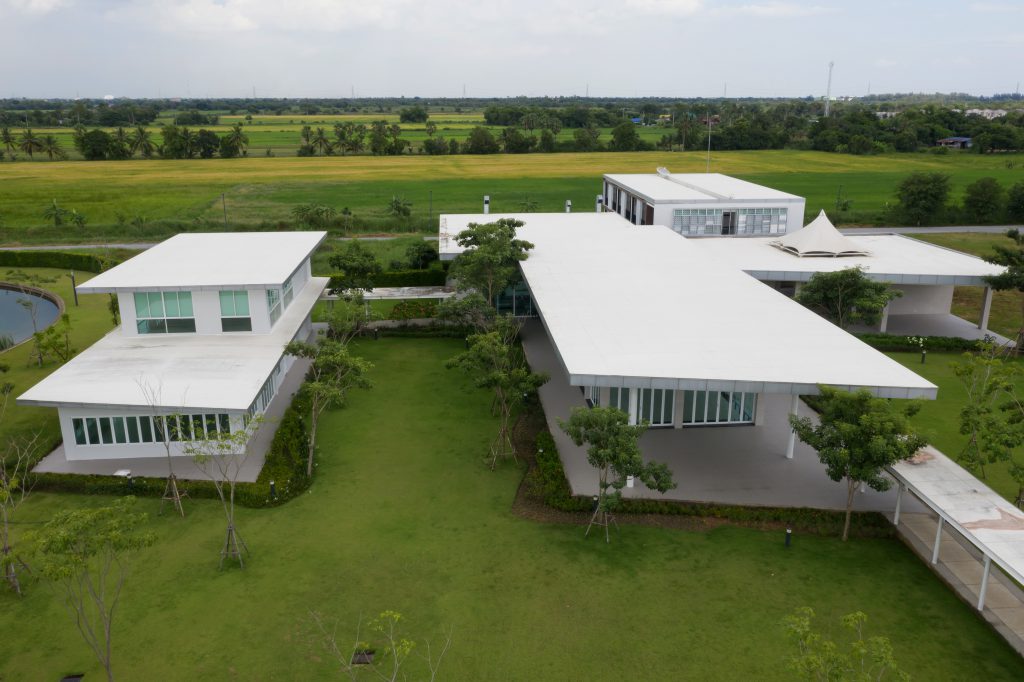
Photo: Ketsiree Wongwan
The cycle of life and death and the process of what comes in between is inescapable, yet death still seems terrifying, especially to those stricken with incurable disease realizing their time to depart will soon come.
This begs the question of how one can prepare for the final chapter in life, carrying themselves and those closest to them through the pain and injustice of the illness in preparation for death infinite. There remain many questions regarding the choice of an optional serene and humane death assisted by a qualified physician. However, only a handful of countries support this through legalization. Thailand, like most countries, do not legitimize this procedure, instead offering terminally ill assistance in their last weeks and days of life access to palliative care. This system endeavors to provide a level of comfort to the dying through the application of holistic pain relief medication.
When patients are diagnosed as incurable or in severe terminal stages of illness, many related health care issues arise for both the patients and relatives. These may include high levels of physical, emotional, spiritual, and financial stress. This generally runs parallel with organizing health care service provisions such as hospital in-patient and relative accommodation, counseling, medical treatments, dietary regimes, medication therapy, and an elevated level of specialist medical and nursing care.
While a significant proportion of patients seemingly favor to pass-on under their own terms, in their own home surrounded by their family, there remains the question of the likely inability of either the dying or the family having fully prepared for such an ending. Palliative (hospice) care focuses on the palliation of the terminally ill whose objective is providing assistance in a patient’s physical pain and symptoms while attending to their emotional and spiritual needs at the end of their life. The care prioritizes comfort and quality of life remaining by reducing the pain and suffering of the patient.
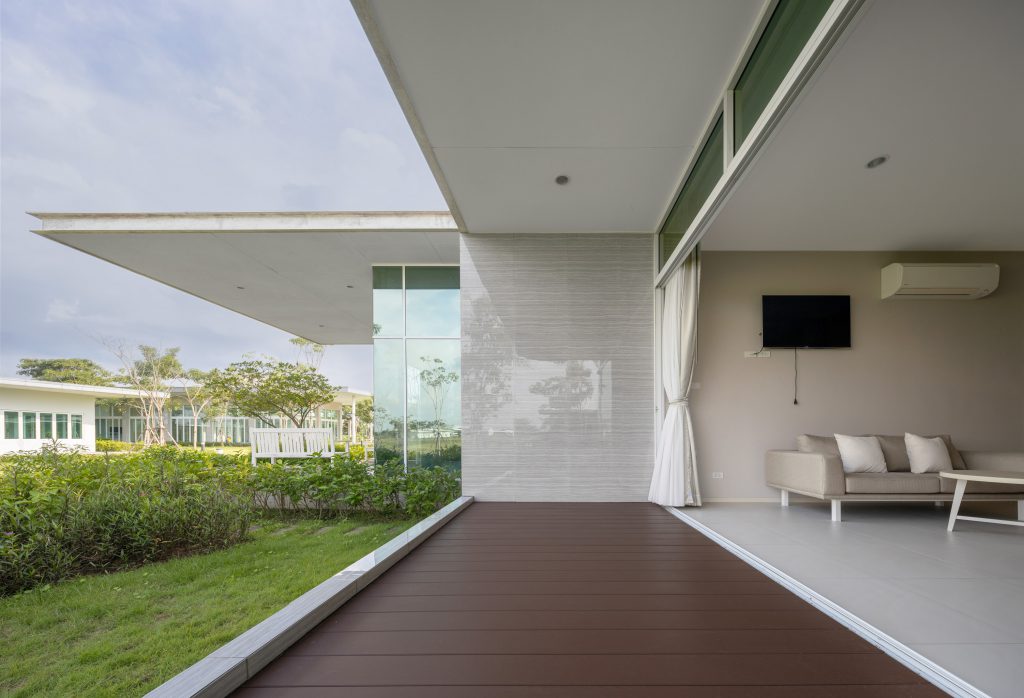
Photo: Ketsiree Wongwan
The care prioritizes comfort and quality of life remaining by reducing the pain and suffering of the patient.
This level of care is undertaken by teams of specialists from various medical disciplines who pro- vide such services and assistance into the patient’s final life phase and subsequent family or caregiver bereavement phase. One such facility providing these services is Pink Park Village, one of the first established hospice care centers in Thailand. It was established purely as a not-for-profit care center for patients diagnosed with terminal phase breast cancer and is managed by the Queen Sirikit Centre for Breast Cancer Foundation.
The center stands on 121 rai of farmland near Nong Chok donated to the foundation by Khun Boonsomsuk Jaruwatana, to be used specifically for the project. Both business and social sectors continue to raise project funding ranging from monetary donations to construction materials and associated costs.
The center’s operations cover the care of terminally ill patients and is a convalescence center for patients going through treatment phases, it also caters as a daycare & activity center, a learning & training center, a diagnostic center, a multi-faith spiritual and religious support center as well as an organic farming community.
The foundation’s president, Dr. Kris Chatamra stated that his intention for the project is “To raise the level of treatment and care for breast cancer patients in Thailand to international standards so that the foundation can truly become a refuge for Thai women.”

Photo: db Studio
Every building was designed to be aesthetically pleasing with ample space with a significant outlook into a natural environment highlighted with landscaping treatment.
During treatment processes, terminally ill cancer patients and those close to them are typically physically, emotionally, and spiritually fragile. It is for this reason that natural therapies are sought and applied to emphasize positive conditions essential to the quality of life in creating a sense of happiness, peace, and tranquility.
The design and landscape architecture studio P Landscape presents the concept of “Landscape Architecture Is the Creation of Life.” The concept involves blending small building structures with different functions within an environmental ‘scene’ in which integrated landscaped gardens are allowed to consume up to more than half of the project’s available space. Adaptive organic plantations are prepared which form part of the planned immediate environment and relationship with surrounding local communities.
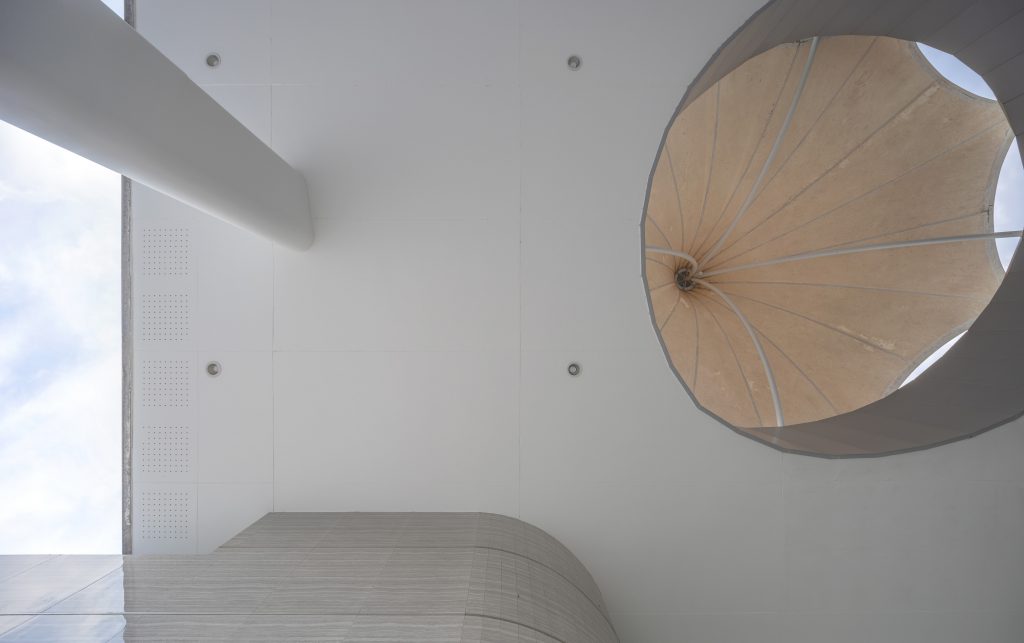
Photo: Ketsiree Wongwan
The idea of permaculture is applied to convey the notion of growth and change, all of which form part of the life cycle. The design highlights the axis which is the core focus of the project by creating a landscape through the integration of an attractive and substantial neotropical tree – ‘pink trumpet’. The flowers of the tree were chosen as being symbolic of breast cancer. Other prominent features within the scenery is an integration of grass fields and pink flowers covering internal walkways and functional water well providing a sense of place and a visual focus in a serene and relaxing natural atmosphere, one that is conducive to healing, health, and well-being.
All users take part in the natural therapy design process, patients, healthcare workers and caregivers from various disciplines actively brainstorm together in workshop sessions to develop ideas and design choices for different parts of the complex to ensure that the terminally ill patients will be provided with a high quality of life. Every building was painstakingly designed to be aesthetically pleasing with ample space with a significant outlook into a natural environment high-lighted with landscaping treatment.

Photo: Ketsiree Wongwan
Co-project architects, I’ll Design Studio and DB Studio prepared lobbies with installations of art while separating patient rooms either side of a central nurse station and common entertainment/ recreation area in each individual building complex that are open to unobstructed views of surrounding gardens. Floor levels are raised 1.2 meters above walkways to minimize sightlines into private occupied and staffed spaces. The designers also present ideas for a sense of place for worship of different religious faiths around a contemplation pool in natural surroundings allowing freedom for prayer and meditation toward preparation on the final path in life.
Pink Park Village is a significant care-giving example supported through the determination of designers, donators, various user groups, and caregivers that wish to achieve a greater and deeper understanding about this reality and the endeavors they undertake to help alleviate the suffering of others through their contributions.
In terms of the role that designers play, their on-going and developing architectural creativity provides a necessary framework that inspires ideas and motivation both from themselves and others in providing facilities and environments to help meet the needs of the terminally ill raising their quality of life which hopefully, in turn, assists the patients in their ultimate transition into the afterlife.

